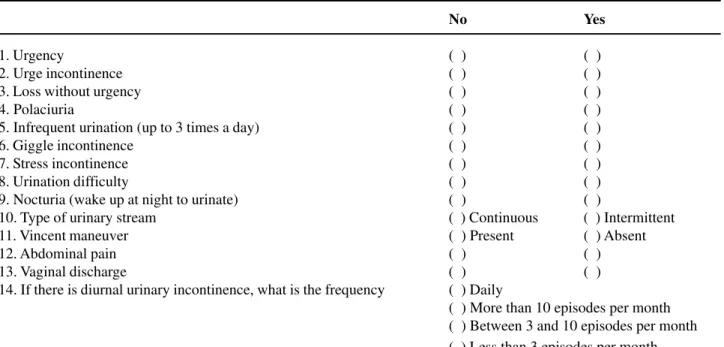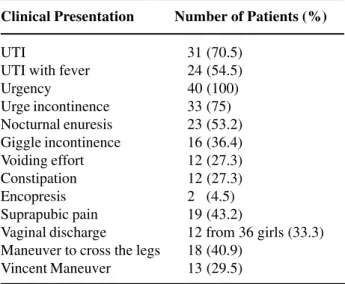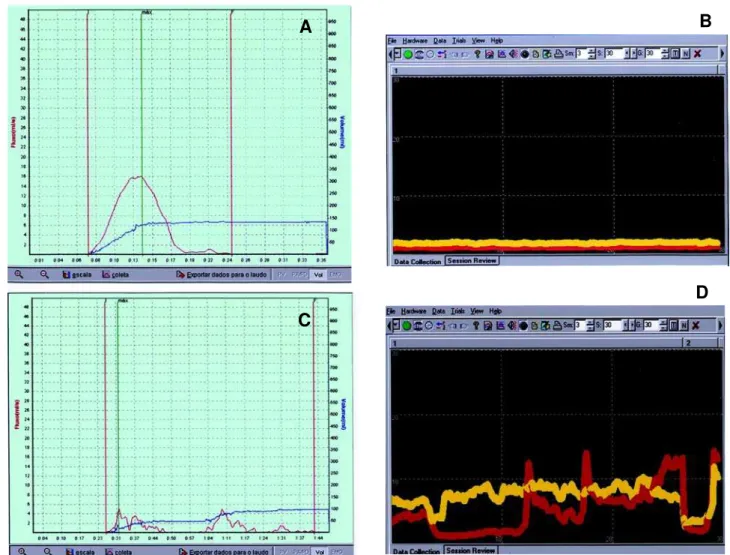Comparative Analysis of the Symptomatology of Children with
Lower Urinary Tract Dysfunction in Relation to Objective Data
Ubirajara Barroso Jr, Thiago Nova, Anderson Dultra, Patricia Lordelo, Juarez Andrade,
Antonio J. Vinhaes
Section of Urology, Federal University of Bahia, Salvador, Bahia, Brazil
ABSTRACT
Objectives:To assess the clinical presentation of children with lower urinary tract dysfunction (LUTD) relating to objective examination data.
Materials and Methods: Forty-four children (36 girls and 8 boys with mean age of 6.8 years) with LUTD were prospec-tively assessed through a specific questionnaire that analyzed clinical presentation of those patients. These data were then compared to objective data, such as micturition diary and uroflowmetry with electromyography.
Results:A urinary tract infection (UTI) antecedent was observed in 31 cases (70.5%), and of those, 24 cases of UTI were accompanied by fever. All children presented micturition urgency. Daily urinary incontinence was observed in 33 cases (75%) and nocturnal enuresis in 23 (52.3%). As for micturition frequency, 15 (34.1%) had normal frequency 19 (43.2%) presented more than 10 daily micturition episodes and 10 (22.7%) thought they urinated less than 5 times a day. In the uroflowmetry and electromyography examination, 14 (31.8%) experienced lack of coordination during micturition. Of 10 children with infrequent micturition, 5 confirmed this in their micturition diaries and 2 listed more than 5 micturition episodes per day in the diary. Of 19 patients presenting polaciuria, only 5 confirmed this in their micturition diaries, while 7 had less than 10 micturition episodes per day.
Conclusion:Most children with LUTD presented a previous UTI, and daily incontinence was verified in around 75% of the patients. Complaints of polaciuria or infrequent micturition are not noted completely in the micturition diaries and there is no parameter in the clinical history that offers good sensitivity or specificity for the diagnosis of lack of perineal coordina-tion.
Key words:children; urination disorders; urinary tract infections; neurogenic bladder
Int Braz J Urol. 2006; 32: 70-6
INTRODUCTION
Lower urinary tract dysfunction (LUTD) is a clinical term related to urination disorders that occur in children without neurological alterations. The dys-function is related to vesicoureteral reflux (present in 15 to 50% of patients with vesical instability) (1,2) and urinary infection in children is an important risk
factor for renal scars and secondary arterial hypoten-sion (3-6).
with low self esteem, it has already been demonstrated that there is a normalization of the general psycho-logical picture with a successful treatment of incon-tinence (9).
It is clinically presented with urination urge and urge incontinence, with the possibility of other symptoms such as polaciuria, infrequent urination and suprapubic or perineal pain.
In relation to urodynamic findings, LUTD can be divided into 2 different groups (10). In the first group we observe intense detrusor non-inhibited con-tractions during the bladder filling phase that is op-posed to pelvic floor muscle contractions and vers to retain the urine, such as the Vincent maneu-ver (11) and crossing the legs. In the second group, there is incomplete relaxation of the sphincter block-ing urination and causblock-ing a prolonged or interrupted urinary stream.
The objective of the present study was to pro-spectively assess the clinical presentation of children with LUTD, correlating with objective data such as urinary diary and uroflowmetry with
electromyogra-phy and assessing the sensitivity and the specificity of parameters of the clinical history in relation to the ex-ams utilized. To our knowledge, there are no available data in the literature that use this type of correlation.
MATERIALS AND METHODS
Forty-four children with LUTD (36 girls and 8 boys, with a mean age of 6.8 years, varying from 3 to 17 years) were retrospectively assessed by means of a specific questionnaire that analyzed the clinical presentation of those patients (Table-1). This ques-tionnaire was applied jointly to parents and children. The initial assessment protocol was composed of a clinical symptoms questionnaire, simple abdomen radiography and a voiding cystourethrogram (in the event of a history of urinary infection), uroflowmetry with electromyography and ultrasonography of the urinary apparatus with a measure of residual urine. The electromyography was performed together with the uroflowmetry, with surface electrodes placed in
Table 1 – Questionnaire aimed at parents. Each question was fully explained to the interviewee so that he/she could understand.
No Yes
1. Urgency ( ) ( )
2. Urge incontinence ( ) ( )
3. Loss without urgency ( ) ( )
4. Polaciuria ( ) ( )
5. Infrequent urination (up to 3 times a day) ( ) ( )
6. Giggle incontinence ( ) ( )
7. Stress incontinence ( ) ( )
8. Urination difficulty ( ) ( )
9. Nocturia (wake up at night to urinate) ( ) ( )
10. Type of urinary stream ( ) Continuous ( ) Intermittent
11. Vincent maneuver ( ) Present ( ) Absent
12. Abdominal pain ( ) ( )
13. Vaginal discharge ( ) ( )
14. If there is diurnal urinary incontinence, what is the frequency ( ) Daily
the perineal and abdominal region to also register the activity of the rectus abdominal during urination. With this assessment, the child’s urodynamic is studied in a non-invasive manner allowing us to correctly clas-sify the LUTD. The performance of the complete urodynamic study (invasive) remained restricted to the cases where there was upper urinary tract dila-tion associated to or present in those children with symptoms that were unreceptive to clinical treatment. The symptomatology of patients was then compared to the findings in both the urination diary and the uroflowmetry, as they are objective parameters.
The criteria of exclusion were neurological alterations or clinical signals suggesting spina bifida occulta, such as tufts of hair, lipomas and spots in sacral region, or anatomic alterations, such as poste-rior urethral valve, ureterocele and ectopic ureter.
The statistical analysis was performed through an assessment of the frequency symptoms related to the disease and the sensitivity and specific-ity of the various forms of clinical presentation and the complementary clinical exams used. The sensi-tivity and specificity were calculated using the fol-lowing formulas: number of patients with a certain symptom divided by the number of children with sphincteric dysfunction, and number of children out symptoms divided by the number of children with-out sphincteric dysfunction.
RESULTS
Previous urinary infection showed up in 31 cases (70.5%), with 24 (54.5%) presenting episodes of UTI with fever. The distribution of the clinical presentation frequencies is demonstrated in Table-2.
In terms of urinary frequency, 15 (34.1%) had normal frequency, 19 (43.2%) voided more than 10 times a day and 10 (22.7%) patients thought they uri-nated less than 5 times a day. Correlating clinical symptoms with objective data, we observed that of the 10 children with infrequent urination, 5 confirmed this in their urination diaries. Of the 19 patients claim-ing polaciuria, only 5 (26%) confirmed this in the diary, while 7 (37%) urinated less than 10 times per
day and 7 did not fill out the diary. These figures are represented in Table-3.
The frequency of maneuvers to retard urina-tion, such as the Vincent maneuver and crossed legs, as well as constipation frequency (characterized as more than 2 days without defecating) and encopre-sis, are demonstrated in Table-2. The occurrence of occasional suprapubic region pain and vaginal run-ning are also registered in this Table.
Even though cystourethrogram was indicated in all cases with urinary infection [31], only 23 chil-dren took it. A presence of vesicoureteral reflux was verified in 3 patients (13%).
In the uroflowmetry assessment with elec-tromyography, 14 patients (31.8%) experienced lack of coordination in micturition (Figure-1). Only 5 pa-tients were submitted to a complete urodynamic study. Sensitivity and specificity of some parameters of the clinical history in relation to the incoordina-tion in micturiincoordina-tion obtained by means of uroflowmetry with electromyography were respec-tively: Vincent maneuver - 50% and 68%; crossing the legs - 66% and 45%; urination difficulty - 41% and 71%; interrupted stream - 25% and 63%; and constipation - 30% and 68%.
Table 2 – Distribution of clinical presentations on low uri-nary tract dysfunction in 40 children.
Clinical Presentation Number of Patients (%)
UTI 31 (70.5)
UTI with fever 24 (54.5)
Urgency 40 (100)
Urge incontinence 33 (75) Nocturnal enuresis 23 (53.2) Giggle incontinence 16 (36.4) Voiding effort 12 (27.3) Constipation 12 (27.3)
Encopresis 2 (4.5)
Suprapubic pain 19 (43.2)
Vaginal discharge 12 from 36 girls (33.3) Maneuver to cross the legs 18 (40.9)
COMMENTS
Even though the LUTD is well described in children, few prospective studies have been accom-plished and, to our knowledge, none have assessed the incidence of the most frequent urinary claims. As well, we do not know if the symptoms are well correlated to the objective data obtained from the urination diary, the ultrasonography assessment of the residual urine and the uroflowmetry with elec-tromyography. LUTD in the child is a clinical con-dition that predominantly affects girls. Hanna et al. have noted an incidence of 90% in girls (7). In the present study, the larger prevalence in females is confirmed (81.8%). The most affected age group was from 3 to 7 years of age (7). In this study, the mean age was 6.8 years.
The relationship between LUTD and urinary infection is of utmost importance in the follow-up of those children, and it presents therapeutic and prog-nostic implications. Children with vesicoureteral flux (VUR) and LUTD have a larger chance of re-fractory infection than those children without LUTD. Snodgrass found that children with VUR and LUTD presented refractory infection in 44% of cases (12), while those with only VUR had an incidence of 11%. A precedent urinary infection was observed in 70.5% of children assessed in this study; of those, 77.4% had already presented some episode of UTI with fe-ver.
Among the symptoms associated with LUTD, urgency and urge incontinence are the most preva-lent. Urgency was observed in all child studies, with reports of diurnal urinary incontinence found in 75% of the cases. Nocturnal enuresis (52.3%) and
urina-tion difficult (27.3%) were also frequent complaints. Giggle incontinence was a symptom present in 23% of children with diurnal urination symptoms (13), having been observed in 36.4% of children accessed in the present study. In an analysis of 1421 children 5 to 15 years of age, Chandra et al. noticed the pres-ence of laugh urinary incontinpres-ence in 109 (7.7%) (13). Alterations in urinary frequency were found in 66% of children. Among assessed patients, 43.2% reported that void more than 10 times a day, while 22.7% thought that they urinated less than 5 times a day.
In the attempt to retain urine in the bladder, the child tends to contract the pelvic muscles, some-times assuming the classic posture to achieve that (Vincent maneuver) (11), and crossing the legs. Ma-neuvers to retain the urine in the bladder were ob-served in at least half the children studied. Children with detrusor instability that use postural maneuvers to retain urine have a higher incidence of urinary tract infection than those who do not try to obstruct the urinary flow (14).
It is already known that alterations in intesti-nal habits have a great influence on the function of the low urinary tract and can be associated with a syndrome that Koff et al. described as elimination dysfunction (15). Among children studied, 27.3% claim constipation and 4.5% presented encopresis. The association of LUTD in girls with some degree of vaginal discharge was not found in the literature, but it was observed in the current study in one third of the female cases. The hypothesis is that there is a urine reflux in the vagina of the girls with LUTD, which generates colpitis and vaginal discharge; how-ever, there is a need for more studies in this area in order to prove this correlation.
Table 3 – Correlation between reported urination frequency observed through clinical history and through the urination diary.
Number of Urinations in the Diary
Symptoms (anamnesis) < 5 urinations 5-9 > 10 Without diary Total
Infrequent urination 5 2 0 3 10
The association between urinary tract infec-tion, vesicoureteral reflux, LUTD and the formation of renal scars is already well established. Data in the literature show the presence of VUR in 15 to 50% of patients with vesical instability (1,2). In children with LUTD assessed per voiding cystourethrogram (VCU) in this study, the occurrence of RVU was observed in 13% of the cases. Due to the improvement in reflux with the clinical treatment of LUTD and the low in-cidence of RVU in this group of patients (1,16), we should discuss the need to perform a VCU in these
cases. In cases of LUTD, a cystourethrogram can not only assesses the presence of associated vesicoureteral reflux, but also demonstrates the signals of vesical instability (spinning top urethra, serrulated bladder wall, bladder elongation and, in extreme cases, pres-ence of diverticula). In analyzing 193 children with RVU, Barroso et al. found sings of vesical instability in the cystourethrogram in 26% of the patients (17). These findings demonstrated that among children that presented symptoms of LUTD, 64% had cystoure-throgram. However, no study that came to our knowl-Figure 1 – Normal child, presenting uroflowmetry with normal urinary flow spinning top shape (A) and electromyography with ab-sence of perineal and abdominal muscular activity (B). Child with interrupted urinary flow (C) and sphincteric incoordination, with electromyography evidencing abdominal and perineal activity during urination (D).
A
B
C
edge assessed the prognostic value of these findings in this group of patients.
It is of utmost importance for the treatment of children with LUTD that a differential diagnosis be performed regarding the urge syndrome, urination dys-function (sphincteric dysdys-function) and the lazy blad-der syndrome. In orblad-der to make this differential diag-nosis, data alone from the patient’s clinical history are imprecise and insufficient (18). The weak correlation between the symptomatology presented by the patient and the objective results of complementary exams was confirmed in this study. Of the 10 children reporting infrequent urination, half confirmed this finding through their urination diaries. Of the 19 patients with polaciuria, only 26.3% confirmed this in the diary. Sensitivities and specificities of parameters from the clinical history in relation to the objectives findings of voiding incoordination obtained through uroflowmetry with electromyography were equally low. The discov-ery of maneuvers to retain urine presented little corre-lation with the diagnosis of lack of perineal coordina-tion. As well as the report of urination difficulty and the claim of interrupted stream, Vincent maneuvers (11) and crossing the legs showed a weak correlation with the results obtained through the non-invasive urodynamic assessment. Due to the low correlation between the symptoms of LUTD and the results of the exams, the present study shows that there is little cor-relation between LUTD symptoms and the assessment through the urination diary and uroflowmetry with elec-tromyography. This suggests a need to perform a non-invasive urodynamic to classify children with lower urinary tract dysfunction.
CONFLICT OF INTERESTS
None declared.
REFERENCES
1. Koff SA, Lapides J, Piazza DH: Association of uri-nary tract infection and reflux with uninhibited blad-der contractions and voluntary sphincteric obstruction. J Urol. 1979; 122: 373-6.
2. Snodgrass W: Relationship of voiding dysfunction to urinary tract infection and vesicoureteral reflux in chil-dren. Urology. 1991; 38: 341-4.
3. Varlam DE, Dippell J: Non-neurogenic bladder and chronic renal insufficiency in childhood. Pediatr Nephrol. 1995; 9: 1-5.
4. Naseer SR, Steinhardt GF: New renal scars in chil-dren with urinary tract infections, vesicoureteral re-flux and voiding dysfunction: a prospective evalua-tion. J Urol. 1997; 158: 566-8.
5. Barroso U Jr, Barroso DV, Jacobino M, Vinhaes AF, Macedo A Jr, Srougi M: Etiology of urinary tract in-fection in scholar children. Int Braz J Urol. 2003; 29: 450-4.
6. Barroso U Jr, Jednak R, Barthold JS, Gonzalez R: Outcome of ureteral reimplantation in children with the urge syndrome. J Urol. 2001; 166: 1031-5. 7. Hanna MK, Di Scipio W, Suh KK, Kogan SJ, Levitt
SB, Donner K: Urodynamics in children. Part II. The pseudoneurogenic bladder. J Urol. 1981; 125: 534-7. 8. von Gontard A, Lettgen B, Olbing H, Heiken-Lowenau C, Gaebel E, Schmitz I: Behavioural problems in chil-dren with urge incontinence and voiding postponement: a comparison of a paediatric and child psychiatric sample.. Br J Urol. 1998; 81 (3 Suppl): 100-6 9. Hagglof B, Andren O, Bergstrom E, Marklund L,
Wendelius M. Self esteem before and after treatment in children with nocturnal enuresis and urinary incon-tinence. Scand J Urol Nephrol. 1997;158: 1035-9. 10. van Gool JD: Dysfunctional voiding: a complex of
blad-der/sphincter dysfunction, urinary tract infections and vesicoureteral reflux. Acta Urol Belg. 1995; 63: 27-33. 11. Vincent SA: Postural control of urinary incontinence.
The curtsy sign. Lancet. 1966; 2: 631-2.
12. Snodgrass W: The impact of treated dysfunctional voiding on the nonsurgical management of vesicoureteral reflux. J Urol. 1998; 160: 1823-5. 13. Chandra M, Saharia R, Shi Q, Hill V: Giggle
inconti-nence in children: a manifestation of detrusor instabil-ity. J Urol. 2002; 168: 2184-7; discussion 2187. 14. Hellerstein S, Linebarger JS: Voiding dysfunction in
pediatric patients. Clin Pediatr (Phila). 2003; 42: 43-9. 15. Koff SA, Wagner TT, Jayanthi VR: The relationship among dysfunctional elimination syndromes, primary vesicoureteral reflux and urinary tract infections in children. J Urol. 1998; 160: 1019-22.
17. Barroso U Jr, Vinhaes AJ, Barros M, Barroso VA, Calado AA, Zerati Filho M. Findings in cystourethrography that suggest lower urinary tract dysfunction in children with vesicoureteral reflux. Int Braz J Urol. 2004; 30: 504-7.
18. Barroso U Jr, Macedo A Jr: Disfunção do trato Urinário inferior em crianças. In: Macedo A Jr, Lima SVC, Streit D, Barroso U Jr. Urologia Pediátrica, Roca. 2004; pp. 33-52.
Accepted after revision: August 31, 2005
Correspondence address: Dr. Ubirajara Barroso Jr.



